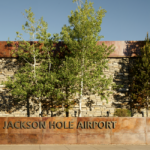Work on a variety of capital projects began during the spring of 2025 at the Jackson Hole Airport (JAC). These projects include environmental projects, refurbished & replaced infrastructure projects, and routine maintenance. Safety, efficiency, and protecting the environment are top priorities at JAC, and these commitments are considered with every project as they conceived, designed, and developed.

Projects
Refurbished & Replaced Infrastructure Projects
Airport Administration/Fixed Based Operator (FBO) Terminal & Hangar 4 Demolition
Hangar 4 was over 30 years old and was demolished in Late April of 2024. In its place will stand the facility used for Airport Administrative Offices and the FBO Terminal.
Upon completion, this building will be the most environmentally respectful facility Jackson Hole Airport has constructed to date.
Environmental Projects
Deicing Pad – Multiyear Project
The deicing pad is being expanded to increase deicing pad capacity. The glycol (aircraft deicing fluid) collection system will also be modified to accommodate the larger deicing pad, which allows spent glycol to be captured, separated from run-off water, and recycled or removed.
The deicing access taxilane and the north taxiway A will also undergo rehabilitation to allow aircraft queuing for deicing to wait on the access taxilane which will improve efficiency and eliminates the need for aircraft to wait on designated aircraft parking spaces needed for other planes.
These improvements will increase deicing capacity and operational efficiency by reducing aircraft deice times, departure delays caused by deicing needs, and wait times experienced with the current pad configuration.
The rehabbed taxiway leading up to the deicing pad will reduce emissions from idling aircraft by allowing them to wait for deicing services close to the pad instead of parking at a designated gate close to the terminal.
The Deice Pad & Taxiway A – North Improvements Project will be split into 2 Phases.
Phase 1 includes taxilane and taxiway rehabilitation. Phase 2 will include expansion of the deice pad and glycol collection system. Work relative to Phases 1 and 2 began in 2023 and the project is expected to be completed in 2026.
FAQs
A. Rebuilding the facility is necessary because the current structure has reached its end-of-life. Upon completion the new structure will provide airport staff with much-needed administration offices, training, and meeting spaces. The ground level floor of the proposed facility will be utilized by FBO staff, pilots, and customers to serve general aviation aircraft. The ground level includes FBO staff offices, operations and fueling support spaces, pilot flight planning center, and a lobby. The basement level includes additional support and storage space.
A. Terminal facilities do not influence a customer’s or pilot’s decision to travel to Jackson Hole. The rebuilt offices and terminal will provide a facility that incorporates safe, efficient, and industry-leading environmental standards that are consistent with the rest of the facilities at the Airport. An increase in general aviation traffic is not anticipated.
A. Airport revenues and revenue bonds will be used to pay for the facility. Sources of airport revenue include fuel sales, landing fees, and hangar rents. The revenue bonds (loan) used for the construction of this facility will be paid back over time using FBO revenues.
The Airport does not receive any local sales or property tax dollars and the costs associated with each facility at the Airport are paid for by the revenue generated by the users of those facilities.
A. Click here to sign up for notifications.
The Airport stockpiles materials dug up during construction projects and reuses it. The large pile of dirt located to the south of the runway will always remain between 20-40ft tall as materials are excavated and reused. Having native materials remain onsite for future projects reduces the number of construction trucks on our local roadways as materials are not being trucked in or out of the facility.
A. Please contact the Airport by emailing community@jhairport.org or calling (307) 733-7695.
Airport Notifications
Sign up for Airport notifications so the communications team can help you stay in the know.
